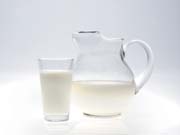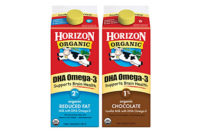

UF milk is a fluid ingredient that contains lower levels of lactose and higher levels of protein than regular milk. During the UF process, milk is passed through a membrane that separates the components by size. The larger milk proteins and milkfat become the retentate stream, or UF milk, while the water, lactose and milk minerals become the permeate stream. The dry version of this product is called milk protein concentrate.
An additional process called diafiltration results in additional carbohydrate removal. Diafiltration involves adding water to the retentate as it is being ultrafiltered to reduce product viscosity and remove even more lactose and minerals.
One of the reasons for the popularity of UF milk is that it has both fresh dairy flavor and good solubility. Manufacturers can also eliminate the step of hydrating a dry dairy ingredient.
Another advantage of UF milk is that the total carbohydrate content can be dropped to lower levels without the use of dietary fibers and sugar alcohols, thus eliminating the "net-carb" definition and the laxative-effect problems that can be associated with too much fiber and sugar alcohol in the diet.
Some manufacturers produce the ingredient in-house for use in their own products, primarily processed cheese. Bruce Blanchard, sales mgr., GEA Filtration, Hudson, Wis., estimates that there are 25 to 30 plants producing UF milk for their own use in the United States. "A few installations process two to three million pounds of UF milk per day," Blanchard says.
DMI is aware of at least three suppliers currently offering UF milk for sale as an ingredient. UF milk is typically shipped in tanker trucks, and further pasteurization or repasteurization is required at the destination site. No U.S. standards of identity exist for any UF milk products, and specifications vary.
UF milk has been marketed commercially since 1996, according to Bob Fassbender, technical dir., TC Jacoby & Co., St. Louis, Mo. The whole milk UF product has been used primarily for cheesemilk standardization. A typical product might contain 10% to 12% protein and less than 5% lactose. "UF skim milk and diafiltered UF skim milk are recent additions, within the past two years," Fassbender says. "These UF ingredients are used to produce an array of lower-carb versions of yogurt, milk and ice cream, as well as some exciting new dairy beverages, including coffee beverages. In a ‘cold-single-pass system,' the lactose level is about 4.5% on a wet basis. With diafiltration the lactose can drop to as low as 1% or less." Diafiltered UF milk is often custom-tailored to meet food manufacturers' specifications for lower-carb dairy products.
UF milk is used to produce the Hood® Carb Countdown™ dairy beverage, which contains 3g of lactose per 8-oz serving, compared to 12g for regular milk. The majority of new product introductions using UF milk are in the yogurt category. Dannon Light ‘n Fit® Carb Control™ cultured dairy snack has 3g carbohydrates and claims 80% less sugar and a third fewer calories than regular low-fat yogurt. Yoplait® Ultra™ with 8g carbohydrates and 5g sugar claims 70% fewer carbohydrates and sugars than regular low-fat yogurt. In addition to containing UF milk, most of these products include added whey protein or nonfat dry milk to boost the protein content. Almost all use sucralose to enhance the sweetness, while a few use a combination of alternative sweeteners.
As these new products do not meet the standards of identity for traditional dairy products, and in the absence of carbohydrate labeling guidelines from FDA, the dairy and beverage industries have created a variety of names and claims to describe these new dairy and dairy-based products. One route has been to use a new product name such as "dairy beverage" or "cultured dairy snack." Other companies have used a nutrient descriptor to modify the name of the traditional dairy product, such as "reduced-sugar, low-fat yogurt."
UF milk is also being used to create lower-carb versions of other popular dairy-based products such as Hood Carb Countdown Lowfat Yogurt Smoothie, which is Atkins®-approved and fortified with whey protein isolate. Skylar Haley, Pleasanton, Calif., has ventured into new territory with its AchieveOne™ coffee beverage with UF milk protein concentrate.
Using UF milk as an ingredient may require some formula adjustments. Lactose not only adds sweetness, it also modifies texture, especially in frozen desserts in which it affects freezing point. DMI application labs can assist product developers working with UF milk to optimize flavor and create a texture more similar to traditional dairy products. Call us at 800/248-8829 to learn how to incorporate UF milk into your next dairy or dairy-based product introduction and for resources on regulatory issues.
